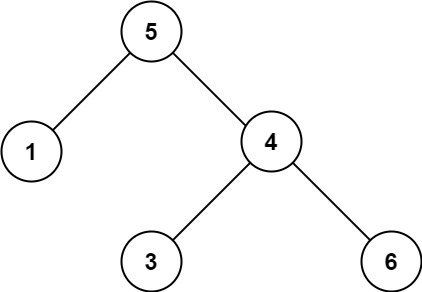Validate Binary Search Tree
Problem
Given the?root?of a binary tree,?determine if it is a valid binary search tree (BST).
A?valid BST?is defined as follows:
- The left?
subtree
?of a node contains only nodes with keys?less than?the node's key. - The right subtree of a node contains only nodes with keys?greater than?the node's key.
- Both the left and right subtrees must also be binary search trees.
Example 1:

Input: root = [2,1,3] Output: true
Example 2:

Input: root = [5,1,4,null,null,3,6] Output: false Explanation: The root node's value is 5 but its right child's value is 4.
Intuition
The task is to determine whether a given binary tree is a valid binary search tree (BST). A binary search tree is a tree in which the left subtree of a node contains only nodes with keys less than the node's key, the right subtree contains only nodes with keys greater than the node's key, and both the left and right subtrees are also binary search trees. The intuition is to perform a recursive traversal of the tree while keeping track of the valid range for each node.
Approach
Initialization:
Define a recursive helper function valid(node, left, right) that checks whether the subtree rooted at node is a valid BST within the given range [left, right].
Start the initial call with the root node and the range [-inf, +inf] representing negative and positive infinity.
Validation:
Check if the current node's value is within the valid range [left, right]. If not, return False.
Recursively call the valid function on the left subtree with the updated range [left, node.val] and on the right subtree with the updated range [node.val, right].
Return Result:
Return True if the entire tree is validated; otherwise, return False.
Invoke Helper Function:
Invoke the helper function with the root node and the initial range [-inf, +inf].
Complexity
- Time complexity:
The time complexity is O(n), where n is the number of nodes in the binary tree. Each node is visited exactly once during the recursive traversal.
- Space complexity:
The space complexity is O(h), where h is the height of the binary tree. This is because the maximum depth of the recursion stack is equal to the height of the tree. In the average case, for a balanced binary tree, the height is O(log n), making the space complexity O(log n). However, in the worst case of an unbalanced tree, the height could be O(n), resulting in a space complexity of O(n). The space complexity is dominated by the depth of the recursive call stack.
Code
# Definition for a binary tree node.
# class TreeNode:
# def __init__(self, val=0, left=None, right=None):
# self.val = val
# self.left = left
# self.right = right
class Solution:
def isValidBST(self, root: Optional[TreeNode]) -> bool:
def valid(node, left, right):
if not node:
return True
if not(node.val < right and node.val > left):
return False
return (valid(node.left, left, node.val)) \
and (valid(node.right, node.val, right))
return valid(root, float('-inf'), float('inf'))本文来自互联网用户投稿,该文观点仅代表作者本人,不代表本站立场。本站仅提供信息存储空间服务,不拥有所有权,不承担相关法律责任。 如若内容造成侵权/违法违规/事实不符,请联系我的编程经验分享网邮箱:chenni525@qq.com进行投诉反馈,一经查实,立即删除!
- Python教程
- 深入理解 MySQL 中的 HAVING 关键字和聚合函数
- Qt之QChar编码(1)
- MyBatis入门基础篇
- 用Python脚本实现FFmpeg批量转换
- SpringBoot的测试
- Oracle-单个PDB的备份脚本以及恢复步骤
- setTimeout和setInterval
- oracle 19c容器数据库data dump数据泵传输数据(4)---网络传输
- ubuntu安装mysql(图文详解)
- Leetcode-102.二叉树的层序遍历(Python)
- Efficient Classification of Very Large Images with Tiny Objects(CVPR2022补1)
- 肯尼斯·里科《C和指针》第6章 指针(3)
- 管理者与员工如何进行高效的一对一面谈?
- Vue3父组件props数据更新后,子组件视图未及时响应更新